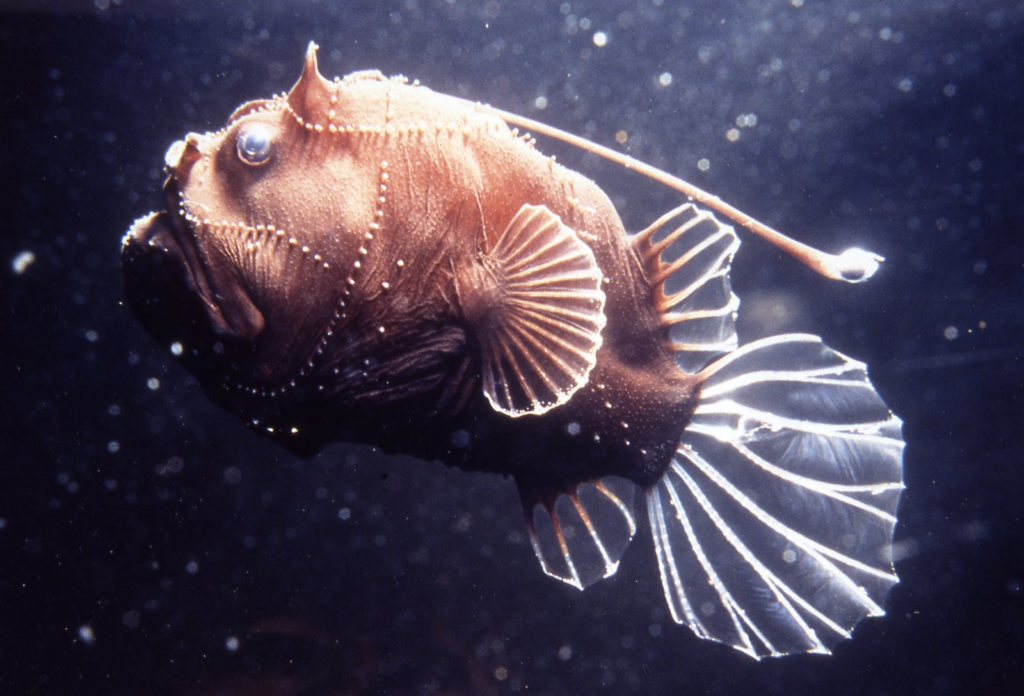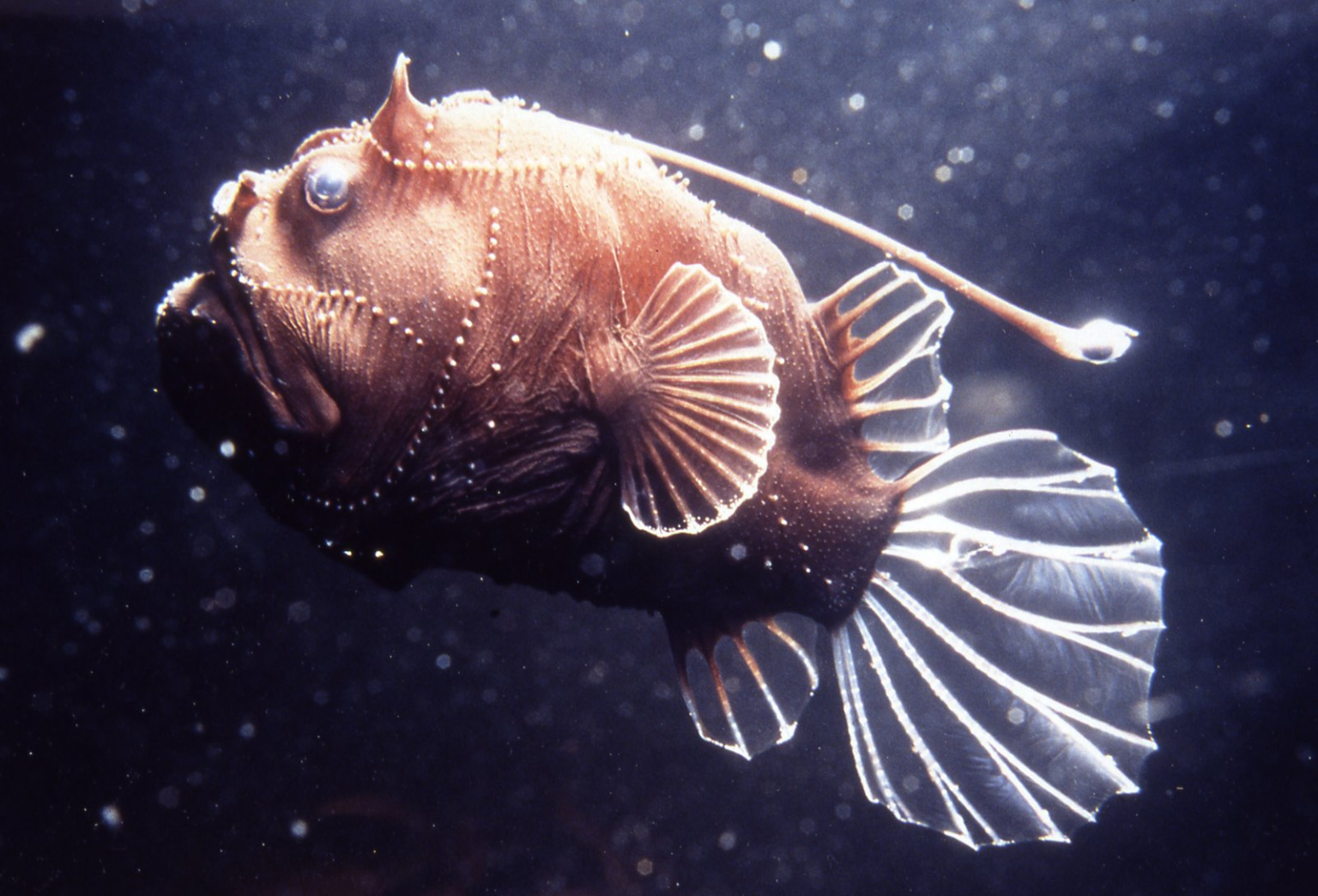The deep sea anglerfish is one of the ocean’s most bizarre and captivating creatures. Known for its eerie appearance and glowing lure, this fish has fascinated scientists and nature enthusiasts alike. It’s a marvel of adaptation, surviving in the most extreme conditions of the ocean. Let’s dive into the depths to understand what makes this fish so unique and how it thrives in the ocean’s darkest corners.
Introduction: The Deep Sea’s Hidden Wonder
Anglerfish are a group of predatory fish that thrive in the dark depths of the world’s oceans. These creatures are notorious for their bizarre, almost alien-like features, such as their bioluminescent lure, large mouths, and sharp teeth. The anglerfish’s name comes from the “fishing pole” that protrudes from its head, a bioluminescent organ that it uses to attract prey in the pitch-black waters. Found primarily in the abyssal and bathypelagic zones—parts of the ocean where sunlight never penetrates—anglerfish have adapted to survive in an environment where most creatures would perish.
What Makes the Anglerfish So Unique?
The Bioluminescent Lure: Nature’s Fishing Rod
One of the most remarkable features of the anglerfish is its bioluminescent lure. This glowing light is produced by bacteria that live in the fish’s specialized organ called the esca. The bacteria emit light, which attracts small fish and other prey to the anglerfish. Once a potential meal approaches, the anglerfish strikes with lightning speed, using its large mouth to engulf the prey.
This method of attracting prey is not only effective but crucial in the deep sea, where darkness reigns. Without the ability to attract food using light, anglerfish would struggle to survive. The glow from their lure is their only beacon in the vast, dark ocean.
Adaptations to Extreme Environments
Anglerfish live in some of the most hostile environments on Earth. The deep sea, where anglerfish are commonly found, has no natural light and is characterized by extreme pressures, cold temperatures, and limited food sources. Despite these challenges, anglerfish thrive thanks to several key adaptations.
One of the most notable adaptations is their ability to survive in extreme pressure. The deep sea is an incredibly harsh environment, with pressures over 200 times that of the surface. Anglerfish have evolved flexible bodies and unique structures that allow them to withstand these pressures without succumbing to damage.
Additionally, anglerfish have a specialized digestive system that helps them make the most of whatever food they catch. The large, expandable stomachs of anglerfish can accommodate meals much larger than their own size, enabling them to survive even when food is scarce.
The Anglerfish’s Appearance: A Glimpse Into the Abyss
Anglerfish are often described as “alien” due to their unusual appearance. They have oversized heads, sharp teeth, and enormous mouths that can open wide enough to swallow prey almost as large as themselves. Their bodies are typically dark in color, often black or brown, to help them blend into the murky depths of the ocean.
Perhaps the most striking feature of the anglerfish is its bioluminescent lure. The esca, a fleshy protrusion from the fish’s head, contains the light-producing bacteria that generate the glow. This lure serves not only as a hunting tool but also as a way to attract mates in the pitch-black ocean.
Sexual Dimorphism: The Male’s Role in the Reproduction Process
Anglerfish exhibit a fascinating form of sexual dimorphism. In many species of anglerfish, males are much smaller than females. In fact, some male anglerfish are so small that they have evolved to become parasitic. When a male finds a female, he bites her and fuses with her body, merging his tissues with hers and living off her bloodstream. The male then remains attached to the female for the rest of his life, providing sperm in exchange for nourishment.
This unusual mating strategy ensures that the female always has access to sperm when she is ready to reproduce. Since food is scarce in the deep sea, this method of reproduction is an adaptation that allows the species to continue despite the challenges of their environment.
Anglerfish Diet: Master of Ambush Hunting
Anglerfish are carnivorous and primarily hunt other fish, squid, and crustaceans. They use their glowing lure to attract prey in the dark, relying on their ambush hunting style to strike when their prey is within reach. The anglerfish’s large mouth and sharp teeth make it a formidable predator, capable of swallowing prey whole.
Because the anglerfish’s environment is so resource-limited, it must make the most of every meal. Anglerfish have developed the ability to consume large quantities of food at once, which helps them survive in an environment where meals are not always abundant.
The Role of Bioluminescence in Hunting
The bioluminescent lure serves more than just a visual purpose. The glow it produces mimics the light produced by other marine organisms, such as small fish or plankton. This illusion tricks the anglerfish’s prey into swimming closer, where the fish can strike with deadly precision. The bioluminescent lure has proven to be one of the most effective methods of hunting in the deep sea.
How Anglerfish Survive in the Darkest Depths
The ocean’s deep zones are a place where sunlight never reaches, and the conditions are harsh and unforgiving. Anglerfish have evolved several traits that enable them to thrive in this dark world.

Pressure Adaptations
As mentioned earlier, anglerfish can survive extreme pressures. At depths of over 2000 feet, the pressure on the anglerfish’s body would be immense. However, anglerfish have evolved flexible bodies and unique internal structures that help them withstand these pressures. Their bones are soft and flexible, which reduces the risk of injury from the immense weight of the water above them.
Cold-Blooded Creatures
Anglerfish, like many deep-sea species, are cold-blooded. This means that their body temperature is regulated by the temperature of their surroundings. In the cold depths of the ocean, where temperatures hover around 40°F (4°C), the anglerfish’s cold-blooded nature allows it to conserve energy and survive in these freezing conditions.
Energy Conservation
Because food is scarce in the deep ocean, anglerfish must be extremely efficient in how they use their energy. They have slow metabolisms that allow them to survive without constant food intake. This helps them conserve energy between hunts, which is crucial in an environment where meals are few and far between.
Where Are Anglerfish Found?
Anglerfish are found in oceans all over the world, primarily in the deep waters of the Atlantic and Pacific Oceans. They can be found at depths ranging from 200 feet to over 8,000 feet below the surface. These depths are inhospitable to most creatures, yet the anglerfish thrives in these extreme conditions.
O2 Priority Anglerfish are most commonly found in the abyssal and bathypelagic zones of the ocean. These zones are located at depths where sunlight does not penetrate, making them one of the darkest and least explored regions of the Earth.
Fun Facts About Anglerfish
Eerie Glow: The glow of the anglerfish’s lure can attract prey from a distance of several feet.
Unusual Mating Habits: Male anglerfish are much smaller than females and often attach themselves to the female’s body for life.
Extreme Survivors: Anglerfish can survive in water temperatures as low as 40°F (4°C) and pressures over 200 times that of the surface.
Unpredictable Ambush: Anglerfish have a sudden and violent strike when they catch prey, snapping their jaws shut in the blink of an eye.
Diverse Species: Nottingham There are more than 200 species of anglerfish, each with its own unique adaptations to deep-sea living.
Frequently Asked Questions (FAQs)
What do anglerfish eat? Anglerfish are carnivores and primarily eat fish, squid, and other small marine creatures. They use their bioluminescent lure to attract prey, then strike when it gets too close.
How do anglerfish survive in the deep sea? Anglerfish have evolved to survive extreme pressure and cold temperatures in the deep sea. They have flexible bodies, slow metabolisms, and can store large meals in their expandable stomachs.
Why do anglerfish have glowing lures? The glowing lure helps anglerfish attract prey in the pitch-black depths of the ocean. The light attracts smaller creatures, who mistake it for food or a mate.
To read more, Click Here

